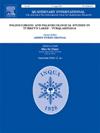A rediscovered fossil hominin fragment from Gombore IB, an early Pleistocene site of Melka Kunture (Upper Awash, Etiopia)
IF 1.8
3区 地球科学
Q3 GEOGRAPHY, PHYSICAL
引用次数: 0
Abstract
The Gombore gully of Melka Kunture is located in the upper Awash Valley of Ethiopia. In the Lower Acheulean layer of Gombore IB, dated to 1.7 million years ago, a well-preserved distal portion of a left humerus was discovered in 1976. Additionally, a proximal fragment of a left humerus was discovered from the same site in 1973; however, it was not initially recognized as belonging to a hominin during excavations. This latter specimen, which was only recently identified within the Gombore I collection, is analyzed here. It is attributed to the middle proximal segment of the bone. The bone presents a significant cortical thickness together with a reduced medullary cavity. Subjected to tomographic examination, it revealed a concentrated cortical structure denoting a young individual. The muscle insertion areas appear well developed and free of apparent musculoskeletal stress. The section appears subcircular with significant diaphyseal torsion that denotes muscular activity. The chronological horizon suggests belonging to Homo erectus. The cross-sectional geometric properties analyses highlight affinity with the first Homo through comparisons with diachronic and synchronic samples. This affinity is probably to be found in the variability of the species and in the bio-complexity at the origin of human evolution.
在Melka Kunture(上阿瓦什,埃塞俄比亚)早期更新世遗址Gombore IB中重新发现的古人类化石碎片
Melka Kunture 的 Gombore 沟位于埃塞俄比亚的阿瓦士河谷上游。1976 年,在距今 170 万年前的 Gombore IB 下阿切乌来岩层中,发现了一具保存完好的左肱骨远端部分。此外,1973 年在同一遗址还发现了左肱骨的近端残片;不过,在发掘过程中,最初并没有发现它属于类人猿。后一件标本直到最近才在贡博雷一号的藏品中得到确认,在此对其进行分析。它被认为是骨骼的中近段。该骨骼的皮质厚度较大,髓腔缩小。通过断层扫描,它显示出集中的皮质结构,表明这是一个年轻的个体。肌肉插入区发育良好,没有明显的肌肉骨骼应力。切面呈近圆形,骺端扭转明显,表明肌肉活动活跃。年代水平表明属于直立人。截面几何特性分析通过与异时和同步样本的比较,突出了与第一批智人的亲缘关系。这种亲缘关系可能存在于物种的变异性和人类进化起源的生物复杂性中。
本文章由计算机程序翻译,如有差异,请以英文原文为准。
求助全文
约1分钟内获得全文
求助全文
来源期刊

Quaternary International
地学-地球科学综合
CiteScore
5.60
自引率
4.50%
发文量
336
审稿时长
3 months
期刊介绍:
Quaternary International is the official journal of the International Union for Quaternary Research. The objectives are to publish a high quality scientific journal under the auspices of the premier Quaternary association that reflects the interdisciplinary nature of INQUA and records recent advances in Quaternary science that appeal to a wide audience.
This series will encompass all the full spectrum of the physical and natural sciences that are commonly employed in solving Quaternary problems. The policy is to publish peer refereed collected research papers from symposia, workshops and meetings sponsored by INQUA. In addition, other organizations may request publication of their collected works pertaining to the Quaternary.
 求助内容:
求助内容: 应助结果提醒方式:
应助结果提醒方式:


